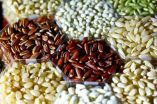(Press-News.org) A plant breeder discovers his experimental crops have been "contaminated" with genes from a neighboring field. New nasty weeds sometimes evolve directly from natural crosses between domesticated species and their wild relatives. A rare plant is threatened due to its small population size and restricted range. What do all these situations have in common? They illustrate the important role of gene flow among populations and its potential consequences. Although gene flow was recognized by a few scientists as a significant evolutionary force as early as the 1940s, its relative role in maintaining a species' genetic integrity and/or its diversity has been debated over the decades, vacillating from trivial to critical.
So how much gene flow is there between plant populations? How important is gene flow for maintaining a species' identity and diversity, and what are the implications of these processes for evolution, conservation of endangered species, invasiveness, or unintentional gene flow from domesticated crops to wild relatives?
Norman Ellstrand, a plant geneticist at the University of California, Riverside, is interested in many aspects regarding gene flow, especially in applied plant biology, and has spent more than 25 years considering the possibility and potential impacts of unintended gene flow from genetically engineered crops. As part of the American Journal of Botany's Centennial Review series, Ellstrand reviews the history of gene flow, focusing on plants, and provides evidence for its importance as an evolutionary force.
Selection, mutation, gene flow, and genetic drift, are the four mechanisms that lead to biological evolution, or a change in allele frequencies in a population over time. Just how important are each of these forces relative to each other?
Interestingly, Ellstrand points out that evolutionary biologists' view on the importance of gene flow has waxed and waned over the last century. Although it was first seen in the 1940s to be the evolutionary glue that held species together, and thus a significant evolutionary force, a few decades later when quantitative data on gene flow in plant populations began being collected, this view changed as evidence seemed to indicate that gene flow was not all that significant.
Not only was intra-specific gene flow among populations seen to be minimal at that time, but, somewhat incongruously, inter-specific hybridization, or the movement of genes among species, was seen to be a much larger force in evolution than intra-specific allele movement. At the time the main concern for plant breeders was pollen movement between different strains of crops—if a variety of sweet corn was contaminated by pollen from a popcorn variety, then the resulting hybrid offspring would produce seeds that were unusable for market purposes or for selecting new varieties. Increasing the distance between plots of different varieties was seen to be the best solution to this problem.
However, beginning in the 1980s the tide turned again due to mounting evidence from new approaches: parentage and spatial population genetic structure studies.
"When I first started doing plant paternity studies in the 1980s," Ellstrand comments, "our lab assumed that gene flow was limited. But we kept identifying 'impossible fathers' that could not be assigned to our study population. Surely, these couldn't be fathers from outside of our wild radish populations—hundreds of meters away? But after excluding all other possibilities, the improbable turned out to be the answer. And the paradigm of limited gene flow in plants began to crumble."
Indeed, one of the amazing things that parentage studies revealed is just how far genes could flow—from hundreds to thousands of meters in some cases. In one extraordinary case, a study found that the nearest possible paternal sire of an individual fig tree was 85 km away!
With the advent of more and more sophisticated ways to measure genetic variation and relatedness using molecular markers, such as allozyme polymorphisms and DNA-based markers, not only can individuals be tracked as to their parentage, but changes in allele patterns over time and thus the effects of evolution on populations can be "seen" in the genetic information.
As it turns out, despite the initial skepticism about the importance of gene flow, modern empirical and theoretical research using up-to-date molecular and DNA techniques have shown us not only how surprisingly far the flow of genes between distant plant populations can be, but also that the flow of alleles among populations is just as important, if not more so in some cases, as natural selection. Indeed, even just a low level of gene flow between populations can counter opposing forces of mutation, genetic drift, and selection.
"Just like selection, gene flow is one of the evolutionary forces—and a potentially important one," notes Ellstrand. And plants are very well suited for studies on gene flow because individuals are stationary yet pollen and seeds are mobile.
However, an important caveat that Ellstrand reports in his review is that the relative importance of gene flow can vary tremendously among species and among populations, and can be as low as no gene flow at all to very high rates of gene flow.
"This review paper tells the story of gene flow's rise to respect among plant evolutionary biologists," he concludes, "a fact that hasn't yet penetrated biology in general that is still mired in selection/adaptation-only thinking."
INFORMATION:
Norman C. Ellstrand. 2014. Is gene flow the most important evolutionary force in plants? American Journal of Botany 101:737-753. doi:10.3732/ajb.1400024
The full article in the link mentioned is Open Access at http://www.amjbot.org/content/101/5/737.full.pdf+html. Reporters may contact Richard Hund at ajb@botany.org for a copy of the article at any time.
The Botanical Society of America is a non-profit membership society with a mission to promote botany, the field of basic science dealing with the study and inquiry into the form, function, development, diversity, reproduction, evolution, and uses of plants and their interactions within the biosphere. It has published the American Journal of Botany for 100 years. In 2009, the Special Libraries Association named the ,American Journal of Botany one of the Top 10 Most Influential Journals of the Century in the field of Biology and Medicine.
For further information, please contact the AJB staff at ajb@botany.org.
What can plants reveal about gene flow? That it's an important evolutionary force
Research examines implications for evolution, conservation of endangered species, invasiveness, and unintentional gene flow from domesticated crops to wild relatives
2014-05-28
ELSE PRESS RELEASES FROM THIS DATE:
In Africa, STI testing could boost HIV prevention
2014-05-28
PROVIDENCE, R.I. [Brown University] — To maximize HIV prevention efforts in South Africa and perhaps the broader region, public health officials should consider testing for other sexually transmitted infections when they test for HIV, according to a new paper in the journal Sexually Transmitted Infections.
STIs can make HIV easier to transmit even after antiretroviral therapy has begun, so rooting out STI co-infections in patients should improve HIV prevention. The new study led by Brown University public health researchers emphasizes that sooner is indeed better than ...
Variety in diet can hamper microbial diversity in the gut
2014-05-28
AUSTIN, Texas — Scientists from The University of Texas at Austin and five other institutions have discovered that the more diverse the diet of a fish, the less diverse are the microbes living in its gut. If the effect is confirmed in humans, it could mean that the combinations of foods people eat can influence the diversity of their gut microbes.
The research could have implications for how probiotics and diet are used to treat diseases associated with the bacteria in human digestive systems.
A large body of research has shown that the human microbiome, the collection ...
Melting Arctic opens new passages for invasive species
2014-05-28
For the first time in roughly 2 million years, melting Arctic sea ice is connecting the north Pacific and north Atlantic oceans. The newly opened passages leave both coasts and Arctic waters vulnerable to a large wave of invasive species, biologists from the Smithsonian Environmental Research Center assert in a commentary published May 28 in Nature Climate Change.
Two new shipping routes have opened in the Arctic: the Northwest Passage through Canada, and the Northern Sea Route, a 3000-mile stretch along the coasts of Russia and Norway connecting the Barents and Bering ...
3,000 rice genome sequences made publicly available on World Hunger Day
2014-05-28
The open-access, open-data journal GigaScience (published by BGI and Biomed Central), announces today the publication of an article on the genome sequencing of 3000 rice strains along with the release of this entire dataset in a citable format in journal's affiliated open-access database, GigaDB. The publication and release of this enormous data set (which quadruples the current amount of publicly available rice sequence data) coincides with World Hunger Day to highlight one of the primary goals of this project— to develop resources that will aid in improving global food ...
High-status co-eds use 'slut discourse' to assert class advantage
2014-05-28
WASHINGTON, DC, May 27, 2014 — A new study suggests that high-status female college students employ "slut discourse" — defining their styles of femininity and approaches to sexuality as classy rather than trashy or slutty — to assert class advantage and put themselves in a position where they can enjoy sexual exploration with few social consequences.
"Viewing women only as victims of men's sexual dominance fails to hold women accountable for the roles they play in reproducing social inequalities," said lead author Elizabeth A. Armstrong, an associate professor of sociology ...
Prehistoric birds lacked in diversity
2014-05-28
Birds come in astounding variety—from hummingbirds to emus—and behave in myriad ways: they soar the skies, swim the waters, and forage the forests. But this wasn't always the case, according to research by scientists at the University of Chicago and the Field Museum.
The researchers found a striking lack of diversity in the earliest known fossil bird fauna (a set of species that lived at about the same time and in the same habitat). "There were no swans, no swallows, no herons, nothing like that. They were pretty much all between a sparrow and a crow," said Jonathan ...
Cod bones reveal 13th century origin of global fish trade
2014-05-28
London's international fish trade can be traced back 800 years to the medieval period, according to new research published today in the journal Antiquity.
The research, led by archaeologists from UCL, Cambridge and UCLan, provides new insight into the medieval fish trade and the globalisation of London's food supply.
Archaeologists analysed data from nearly 3,000 cod bones found in 95 different excavations in and around London. They identified a sudden change in the origin of the fish during the early 13th century, indicating the onset of a large-scale import trade.
Lead ...
Butterfly 'eyespots' add detail to the story of evolution
2014-05-28
CORVALLIS, Ore. – A new study of the colorful "eyespots" on the wings of some butterfly species is helping to address fundamental questions about evolution that are conceptually similar to the quandary Aristotle wrestled with about 330 B.C. – "which came first, the chicken or the egg?"
After consideration, Aristotle decided that both the egg and the chicken had always existed. That was not the right answer. The new Oregon State University research is providing a little more detail.
The study, published today in Proceedings of the Royal Society B, actually attempts to ...
Should sugary drinks carry a health warning?
2014-05-28
In a personal view published on bmj.com today, a professor of public health at a leading university thinks there should be health warning labels on sugary drinks.
Professor Simon Capewell, professor at the University of Liverpool, highlights that the State of California is considering a new health bill. One which will see sugary drinks labelled with health warnings, vending machines to bear warning labels, and fines of between $50 and $500 per failed inspection".
Professor Capewell thinks this is a good idea, and one that the UK public would support.
He says that ...
Higher NHS spending in deprived areas can reduce health inequalities
2014-05-28
A policy of higher NHS spending in deprived areas compared with affluent areas is associated with a reduction in absolute health inequalities from causes amenable to healthcare in England, suggests a study published on bmj.com today.
In 1999, the government introduced a new 'health inequalities' objective for the allocation of NHS resources in England, which resulted in greater NHS spending in deprived areas with the worst health outcomes. But it is not known whether this policy was successful in contributing to a reduction in health inequalities.
So researchers based ...
LAST 30 PRESS RELEASES:
Study: Teens use cellphones for an hour a day at school
After more than two years of war, Palestinian children are hungry, denied education and “like the living dead”
The untold story of life with Prader-Willi syndrome - according to the siblings who live it
How the parasite that ‘gave up sex’ found more hosts – and why its victory won’t last
When is it time to jump? The boiling frog problem of AI use in physics education
Twitter data reveals partisan divide in understanding why pollen season's getting worse
AI is quick but risky for updating old software
Revolutionizing biosecurity: new multi-omics framework to transform invasive species management
From ancient herb to modern medicine: new review unveils the multi-targeted healing potential of Borago officinalis
Building a global scientific community: Biological Diversity Journal announces dual recruitment of Editorial Board and Youth Editorial Board members
Microbes that break down antibiotics help protect ecosystems under drug pollution
Smart biochar that remembers pollutants offers a new way to clean water and recycle biomass
Rice genes matter more than domestication in shaping plant microbiomes
Ticking time bomb: Some farmers report as many as 70 tick encounters over a 6-month period
Turning garden and crop waste into plastics
Scientists discover ‘platypus galaxies’ in the early universe
Seeing thyroid cancer in a new light: when AI meets label-free imaging in the operating room
Neutrophil-to-lymphocyte ratio may aid risk stratification in depressive disorder
2026 Seismological Society of America Annual Meeting
AI-powered ECG analysis offers promising path for early detection of chronic obstructive pulmonary disease, says Mount Sinai researchers
GIMM uncovers flaws in lab-grown heart cells and paves the way for improved treatments
Cracking the evolutionary code of sleep
Medications could help the aging brain cope with surgery, memory impairment
Back pain linked to worse sleep years later in men over 65, according to study
CDC urges ‘shared decision-making’ on some childhood vaccines; many unclear about what that means
New research finds that an ‘equal treatment’ approach to economic opportunity advertising can backfire
Researchers create shape-shifting, self-navigating microparticles
Science army mobilizes to map US soil microbiome
Researchers develop new tools to turn grain crops into biosensors
Do supervised consumption sites bring increased crime? Study suggests that’s a myth
[Press-News.org] What can plants reveal about gene flow? That it's an important evolutionary forceResearch examines implications for evolution, conservation of endangered species, invasiveness, and unintentional gene flow from domesticated crops to wild relatives




